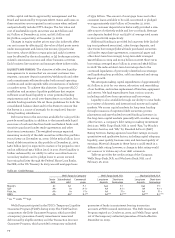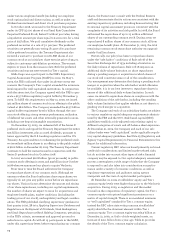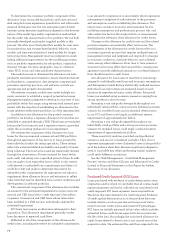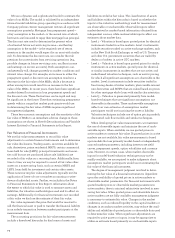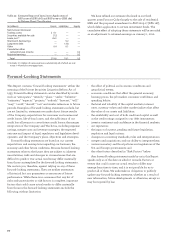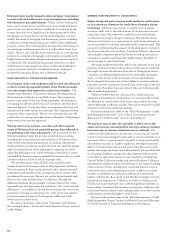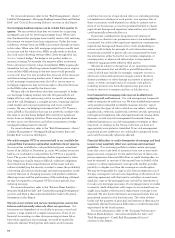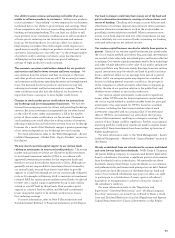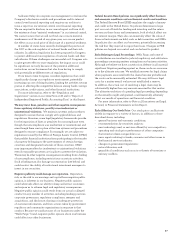Wells Fargo 2009 Annual Report Download - page 80
Download and view the complete annual report
Please find page 80 of the 2009 Wells Fargo annual report below. You can navigate through the pages in the report by either clicking on the pages listed below, or by using the keyword search tool below to find specific information within the annual report.
ACTUARIAL ASSUMPTIONS To estimate the projected benefit
obligation, actuarial assumptions are required about factors
such as the rates of mortality, turnover, retirement, disability
and compensation increases for our participant population.
These demographic assumptions are reviewed periodically.
In general, the range of assumptions is narrow. The compen-
sation increase assumption does not apply to the plans that
were frozen in 2009.
EXPECTED LONG-TERM RATE OF RETURN ON PLAN ASSETS We
determine the expected return on plan assets each year based
on the composition of assets and the expected long-term rate
of return on that portfolio. The expected long-term rate of
return assumption is a long-term assumption and is not
anticipated to change significantly from year to year.
To determine if the expected rate of return is reasonable,
we consider such factors as (1) long-term historical return
experience for major asset class categories (for example, large
cap and small cap domestic equities, international equities
and domestic fixed income), and (2) forward-looking return
expectations for these major asset classes. Our expected rate
of return for 2010 is 8.25%, a decrease from 8.75%, the expected
rate of return for 2009 and 2008. The decrease reflects our
decision to de-emphasize the use of the Tactical Asset
Allocation model. Differences in each year, if any, between
expected and actual returns are included in our net actuarial
gain or loss amount, which is recognized in OCI. We generally
amortize any net actuarial gain or loss in excess of a 5%
corridor (as defined in accounting guidance for retirement
benefits) in net periodic pension expense calculations over
our estimated average remaining participation period of
13 years. See Note 19 (Employee Benefits and Other Expenses)
to Financial Statements in this Report for information on
funding, changes in the pension benefit obligation, and plan
assets (including the investment categories, asset allocation
and the fair value).
If we were to assume a 1% increase/decrease in the expected
long-term rate of return, holding the discount rate and other
actuarial assumptions constant, 2010 pension expense would
decrease/increase by approximately $91 million.
DISCOUNT RATE We use a discount rate to determine the pre-
sent value of our future benefit obligations. The discount rate
reflects the current rates available on long-term high-quality
fixed-income debt instruments, and is reset annually on the
measurement date. To determine the discount rate, we review,
with our independent actuary, spot interest rate yield curves
based upon yields from a broad population of high-quality
bonds, adjusted to match the timing and amounts of the
Cash Balance Plan’s expected benefit payments. We used
a discount rate of 5.75% in 2009 and 6.75% in 2008.
If we were to assume a 1% increase in the discount rate,
and keep the expected long-term rate of return and other
actuarial assumptions constant, 2010 pension expense would
decrease by approximately $33 million. If we were to assume a
1% decrease in the discount rate, and keep other assumptions
constant, 2010 pension expense would increase by approxi-
mately $36 million. The decrease in pension expense due to a
1% increase in discount rate differs slightly from the increase
in pension expense due to a 1% decrease in discount rate due
to the impact of the 5% gain/loss corridor.
Income Taxes
We are subject to the income tax laws of the U.S., its states
and municipalities and those of the foreign jurisdictions in
which we operate. Our income tax expense consists of two
components: current and deferred. Current income tax
expense approximates taxes to be paid or refunded for the
current period and includes income tax expense related to our
uncertain tax positions. We determine deferred income taxes
using the balance sheet method. Under this method, the net
deferred tax asset or liability is based on the tax effects of the
differences between the book and tax bases of assets and lia-
bilities, and recognized enacted changes in tax rates and laws
in the period in which they occur. Deferred income tax
expense results from changes in deferred tax assets and liabil-
ities between periods. Deferred tax assets are recognized sub-
ject to management’s judgment that realization is “more likely
than not.” Uncertain tax positions that meet the more likely
than not recognition threshold are measured to determine the
amount of benefit to recognize. An uncertain tax position is
measured at the largest amount of benefit that management
believes has a greater than 50% likelihood of realization upon
settlement. Foreign taxes paid are generally applied as credits
to reduce federal income taxes payable. We account for inter-
est and penalties as a component of income tax expense.
The income tax laws of the jurisdictions in which we
operate are complex and subject to different interpretations
by the taxpayer and the relevant government taxing authorities.
In establishing a provision for income tax expense, we must
make judgments and interpretations about the application
of these inherently complex tax laws. We must also make
estimates about when in the future certain items will affect
taxable income in the various tax jurisdictions by the
government taxing authorities, both domestic and foreign.
Our interpretations may be subjected to review during
examination by taxing authorities and disputes may arise
over the respective tax positions. We attempt to resolve these
disputes during the tax examination and audit process and
ultimately through the court systems when applicable.
We monitor relevant tax authorities and revise our esti-
mate of accrued income taxes due to changes in income tax
laws and their interpretation by the courts and regulatory
authorities on a quarterly basis. Revisions of our estimate of
accrued income taxes also may result from our own income
tax planning and from the resolution of income tax controver-
sies. Such revisions in our estimates may be material to our
operating results for any given quarter.
See Note 20 (Income Taxes) to Financial Statements in
this Report for a further description of our provision for
income taxes and related income tax assets and liabilities.




